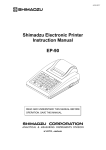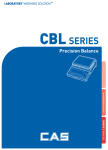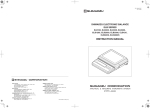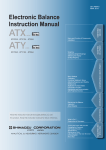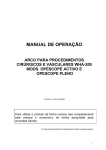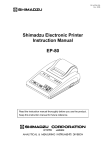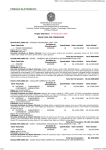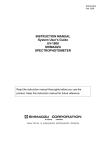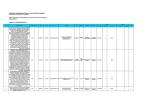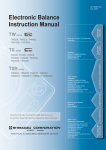Download Directed Electronics 3200HS Instruction manual
Transcript
321-56840-21K
Nov. 2008
ELECTRONIC BALANCE
BL SERIES
BL320S(L), BL620S(L),
BL3200S(L), BL220H(L),
BL320H(L), BL2200H(L),
BL3200H(L)
INSTRUCTION MANUAL
ELECTRONIC BALANCE
BL SERIES
BL320S(L), BL620S(L),
BL3200S(L), BL220H(L),
BL320H(L), BL2200H(L),
BL3200H(L)
INSTRUCTION MANUAL
READ AND UNDERSTAND THIS MANUAL BEFORE
OPERATION. SAVE THIS MANUAL.
Requests
• Provide this manual to the next user in the event that the instrument is transferred.
• To ensure safe operation, contact your Shimadzu Balance representative for installation,
adjustment, or reinstallation after moving the instrument to a different site.
Notices
• The content of this manual is subject, without notice, to modifications for the sake of improvement.
• Every effort has been made to ensure that the content of this manual was correct at the time
of creation. However, in the event that any mistakes or omissions are discovered, it may not
be possible to correct them immediately.
• The copyright of this manual is owned by Shimadzu Corporation. Reproduction and duplication of whole or part of the content without permission of the company are strictly prohibited.
© 2000-2008 Shimadzu Corporation. All rights reserved.
-I-
Notation Conventions
Note
This instruction manual uses the following notation conventions to indicate
Safety Precautions and additional information.
Caution
Note
Indicates a potentially hazardous situation that may
result in injury to personnel or equipment damage.
Provides additional information needed to properly
use the balance.
- II -
Safety Precautions
To be strictly observed
To ensure that you use the balance safely and correctly, read the following precautions carefully and
observe them.
The levels of danger and damage that will arise if the balance is used incorrectly are classified and
indicated as shown below.
WARNING
Indicates a potentially
hazardous situation which,
if not avoided, could result in
serious injury or possibly death.
CAUTION
Indicates a potentially
hazardous situation which,
if not avoided, may result in
minor to moderate injury or
equipment damage.
Precautions are classified and explained by using one of the symbols below, depending on the
nature of the precaution.
Indicates an action that must be
performed.
Instructions
Indicates an action that must
NOT be performed.
Prohibitions
WARNING
Never disassemble, modify or attempt to repair this product or any
accessory.
Prohibitions
You could sustain an electric shock or the product could operate abnormally.
If you believe that the balance has failed, contact your Shimadzu representative.
Use the balance with the specified power supply and voltage.
Instructions
Using the balance with an incorrect power supply or voltage will lead to fire or trouble
with the balance.
Note also that if the power supply or voltage is unstable or if the power supply capacity
is insufficient, it will not be possible to obtain satisfactory performance from the balance.
Use the correct weighing units.
Instructions
Using incorrect weighing units can lead to accidents as a result of weighing errors.
Check that the weighing units are correct before starting weighing.
Do not use the balance outdoors or anywhere where it will be exposed to
water.
Prohibitions
You could sustain an electric shock or the product could operate abnormally.
- III -
CAUTION
Prohibitions
Avoid locations where the balance
will be exposed to any of the
following.
This could cause accidents or poor
performance.
• Air flow from an air conditioner,
ventilator, door or window
• Extreme temperature changes
• Vibration
• Direct sunlight
• Corrosive or flammable gases
• Dust, electromagnetic waves or a
magnetic field
Install the balance on a strong and stable flat table or floor.
Instructions
Placing the balance in an unstable site could lead to injury or trouble with the balance.
When selecting the installation site, take into account the combined weight of the
balance and the item to be weighed.
After a power outage, turn the power back ON.
Instructions
When a power outage occurs, the power is shut off automatically. Therefore, begin
operation from 2. INSTALLATION (4) (^ page 4) again.
Treat the balance with care and respect.
Instructions
The balance is a precision instrument. Subjecting it to impacts could cause it to fail.
When moving the balance, remove pan and pan supporter. Grasp it firmly with both
hands to carry it.
If the balance has to be stored for a long time, store it in the packaging box in which it
was delivered.
Do not connect anything other than peripheral devices specified by
Shimadzu to the balance’s connector.
Prohibitions
If you do, the balance may stop working normally.
In order to avoid trouble, always connect peripheral devices in accordance with the
directions in this manual.
If you detect anything abnormal (e.g. a burning smell) disconnect the AC
adapter immediately.
Instructions
Continuing to use the balance with an abnormality could lead to fire or an electric
shock.
- IV -
Action for Environment (WEEE)
To all user of Shimadzu equipment in the European Union:
Equipment marked with this symbol indicates that it was sold on or after 13th August 2005,
which means it should not be disposed of with general household waste. Note that our equipment is for industrial/professional use only.
Contact Shimadzu service representative when the equipment has
reached the end of its life.
They will advise you regarding the equipment take-back.
With your co-operation we are aiming to reduce contamination from
waste electronic and electrical equipment and preserve natural
resource through re-use and recycling.
Do not hesitate to ask Shimadzu service representative, if you require
further information.
WEEE Mark
-V-
Declaration of Conformity
Manufacturer’s Name: SHIMADZU CORPORATION
Analytical & Measuring Instruments Division
Address :
1, Nishinokyo-Kuwabara-cho, Nakagyo-ku,
Kyoto 604-8511, Japan
declares in sole responsibility that the following product
Product Name
Model Name
P/N
Electronic Balance
BL series
Depend on configuration. See Appendix 1.
referred to in this declaration conforms with following directives and standards
EMC Directive 2004/108/EC
EN 55022:2006 (Class B)
EN 55024:1998 + amendment A1:2001 + amendment A2:2003
EN 61000-3-2:2000 + amendment A2:2005
EN 61000-3-3:1995 + amendment A1:2001 + amendment A2:2005
Low Voltage Directive 2006/95/EC
EN 60950:2001
The last two digits of the year in which CE marking was affixed for Low Voltage
Directive 2006/95/EC are 03.
Note 1) This declaration becomes invalid if technical or operational modifications are
introduced without manufacturer’s consent.
Note 2) This declaration is valid if this product is used alone or in combination with the
accessories of this product which are mentioned in attached Appendix 1 or
other instruments which fulfill with the requirement of mentioned directive.
Note3) Importer/Distributor and Authorised Representative in EU is as follows:
SHIMADZU EUROPA GmbH
Address :Albert-Hahn-Strasse 6-10, 47269 Duisburg, F.R. Germany
Quality Assurance Department
Analytical & Measuring Instruments Division
- VI -
Appendix 1
Product Name : Electronic Balance
Model No.
P/N
With AC adapter
BL-320S
BL-620S
BL-3200S
BL-220H
BL-320H
BL-2200H
BL-3200H
321-61465-52
321-61465-53
321-61465-55
321-61465-42
321-61465-43
321-61465-44
321-61465-45
Without AC adapter
BL-320S
BL-620S
BL-3200S
BL-220H
BL-320H
BL-2200H
BL-3200H
321-61465-32
321-61465-33
321-61465-35
321-61465-22
321-61465-23
321-61465-24
321-61465-25
- VII -
CONTENTS
1.
COMPONENTS AND THEIR NAMES..................................................... 1
2.
INSTALLATION......................................................................................... 3
3.
WARM-UP .................................................................................................. 4
4.
CAUTION NOTES ..................................................................................... 5
5.
MESURING PROCEDURE ....................................................................... 5
6.
MENU SELECTION .................................................................................. 6
6.1
Menu selection when “
” is selected ............................... 8
6.2
Menu selection when “
” is selected ................................... 10
7.
SENSITIVITY CALIBRATION ................................................................. 11
7.1
Setting the value of sensitivity calibration weight................................... 11
7.2
Sensitivity Calibration ............................................................................. 13
8.
REGISTRATION, CANCEL, AND CHANGE OF UNIT.......................... 14
9.
% SETTING................................................................................................ 15
10.
PCS (No. of pieces) SETTING ................................................................... 16
11.
PERFORMANCE CHECKS....................................................................... 17
12.
MAINTENANCE........................................................................................ 18
13.
TROUBLESHOOTING .............................................................................. 19
14.
SPECIFICATIONS...................................................................................... 20
15.
PARTS LIST................................................................................................ 21
16.
PERIPHERAL DEVICES ........................................................................... 22
16.1 The EP-60A Electronic Printer ................................................................ 22
16.2 The IFB-102A RS-232C Interface........................................................... 23
16.3 Input/output Format ................................................................................. 25
16.4 Command Code ....................................................................................... 26
17.
Detailed Information on Unit Conversion................................................... 27
1. COMPONENTS AND THEIR NAMES
Components
Included with every balance are one of the following items.
• Balance body
• AC adapter (option) • protection cover
• Pan
• Pan supporter
• Instruction manual
• Inspection certificate • Breeze guard (Only type, BL220H (L) and
BL320H (L)).
1 Balance body
○
2 Pan
○
3 Pan supporter
○
4 Pan shaft
○
5 Level gauge
○
6 Power jack
○
7 Level screws (3 places)
○
8 Protection cover
○
9 AC adapter (option)
○
10 Data I/O connector
○
11 Breeze guard (Only BL220H (L) and BL320H (L))
○
12 Breeze guard cover (Only BL220H (L) and BL320H (L))
○
-1-
Display and keypad
Display
Keypad
-2-
2. INSTALLATION
Check power
voltage
Caution
• Use only the AC adapter that supplys the output of 12VDC or the
AC adapter provided by the distributor who is authorized by
Shimadzu Corporation.
Caution
• Check the power supply voltage.
Caution
• Check that the supplied power voltage satisfies the displayed value
on the AC adaptor.
Caution
• In order to prevent electric shock when connecting the power, use
a 3P plug with a grounding line or a 2P plug after connecting the
grounding wire to the screw at the back of the case.
Caution
• Do not place anything that makes it difficult to pull the AC adapter
off the outlet.
Installation
site
Avoid installing the balance in a place where:
Caution
• It is exposed to corrosive gas or flammable gas;
Note
• It is exposed dust, wind, vibration, electromagnetic waves, or a
magnetic field;
• It is exposed to direct sunlight or a sudden change in temperature;
Note
or
• It is exposed to extremely high or low temperature or humidity.
Note
Installation (1)
Remove the protection seals (4 places)
from the protection cover and then put
it on the balance body.
(2)
Turn the level screw so that the air
bubble on the level gauge is positioned
at the center of the red circle. Make
sure that the balance never jolt.
For easy adjustment, insert the level
screw on the right back forcibly to the balance body. Then while
lightly pressing the balance top with your hand, adjust the horizontal
level with the level screws on the right front and left front.
Finally, in order to make the balance stable, adjust the right back
screw to touch the floor.
This procedure allows you to level the balance quickly.
-3-
(3)
Place the pan supporter on the pan shaft
and then the pan on the pan supporter.
(4)
Plug the AC adapter into the outlet.
The balance shows
after
self-checking.
(5)
Press the
POWER/BRK
key.
displays light for one minute.
All
Then
the display automatically shows "zero"
and the balance enters measurement
ready state.
(6)
Press the
POWER/BRK
key again.
The standby mark lights up and the
balance enters standby state.
(7)
Warm up the balance.
(8)
Calibrate
the
sensitivity.
Refer
to
“7.
SENSITIVITY
CALIBRATION”.
(9)
Check the performance. Refer to “11. PERFORMANCE
CHECKS”
3. WARM-UP
• Apply power in advance for one hour
or more. This will allow you to
immediately
make
an
accurate
measurement.
• Even if the balance is not used, keep
the standby mark lit (warm-up state)
by pressing the
POWER/BRK
key without disconnecting
the AC adapter.
• If the balance is not used for one month or more, disconnect
the AC adapter.
-4-
4. CAUTION NOTES
• put water, metal pin or any thing in the balance;
Do not......
• open the balance case;
• leave anything exceeding the weighing capacity on the pan;
• expose the balance to anything magnetized;
• connect anything other than the specified equipment to the
connector on the rear side of the balance; and.
• give a shock to the pan.
5. MEASUREMENT PROCEDURE
Preparation
Warm up the balance.
for Weighing
Making a
(1)
Press the
POWER/BRK
key. The
measure-
standby mark goes off and all displays
ment
light. Check that there is no segment
mode
which is not lit.
(2)
The balance shows zero and enters the
measurement mode
Measurement
(1)
When using a tare, load the tare on the
pan and press the
TARE
key after a
stability mark is lit.
(2)
Check that the display shows zero.
(3)
Load a sample. When the stability mark is lit, read the display.
If the total mass of the sample and tare exceeds the weighing
capacity, oL will be displayed.
• Tare................................ A sample container or other.
• Stability mark (→)......... Lights when the displayed value falls within
the stability band. When the load change is
slow, the displayed value will flucutate with
the stability mark lit.
-5-
6. MENU SELECTION
This balance is designed to permit selection of the measuring conditions to compensate
for vibration and other conditions present at the installation site. This feather permits greater
weighing efficiency and accuracy, and is referred to as “Menu Selection”.
Also in BL series, setting the balance to “
” (standard measurement mode)
makes a normal measurement and requires no other setting.
The menu in the BL series consists of three classifications. Basically press the TARE key
to go to lower hierarchy, and press the POWER/BRK key to return to upper hierarchy.
Continuously pressing the POWER/BRK key returns the display to weight display from
each hierarchy with single operation.
Step
(1)
Press the
(2)
“
(3)
Every time the
CAL/MENU
key during the weight display.
” will be displayed.
CAL/MENU
key is subsequently pressed, the
display be changed in the order shown below.
(4)
Select the desired condition and press the
be set or enter into the lower hierarchy.
-6-
TARE
key. Then, it will
• If the measurement is done at severe measurement environment and the stability of the
display is not so good, set the balance to “
” (high-stability mode).
• When the high-speed sample pouring mode is executed, or the small mount of sample
pouring is done, set the balance to “
” (sample mode).
-7-
6.1 Menu selection when “
” is selected
Pressing the TARE key when the “
” is displayed at 1st hierarchy
menu enters 2nd hierarchy menu.
In this menu, ON/OFF of zero tracking, setting the stability detection band,
registration/cancel of unit, ON/OFF of auto print, and ON/OFF of analog display are made.
Key operation and each setting are made as follows.
-8-
Ib
Lb (pound)
tl
Taiwan tael*
tl
Taiwan tael*
tl
Taiwan tael*
none
Sawaran*
none
Kyats*
none
Custom*
(→) : Press the
TARE
(←) : Press the
POWER/BRK
(↓) : Press the
CAL/MENU
• When set to
key.
key.
key.
, satisfactory for most use, the stability mark lights when the display
stays within +/-1 unit (the resolution value of the balance) for a fixed period time.
• When the display shows “
:**,
currently set conditions are displayed on **.
*,
:**,:
• Zero tracking eliminates zero drift, and should be on (
:**”, the
) for normal
weighing. When measuring weight changes over time, or when slowly adding a liquid or
powder to the balance, turn off (
) the zero tracking feature.
* It can be selected in special Area only.
-9-
6.2 Menu display when
Pressing the
TARE
is selected
key when the “
” is displayed at 1st hierarchy
menu enters 2nd hierarchy menu.
In this menu, the input/output format can be set.
(→) : Press the
TARE
key.
(←) : Press the
POWER/BRK
(↓) : Press the
CAL/MENU
• When the display shows “
key.
key.
:**,
:**,
conditions are displayed on **.
-10-
:**,
:**”, the currently set
7. SENSITIVITY CALIBRATION
The electronic balance measures mass by electronicity compensating for terrestrial
gravitation. Since gravitation varies slightly in different regions, span calibration (sensitivity
calibration) is required when the balance is installed. Temperature also effects balance
accuracy, and calibration must be performed whenever a significant change occurs. It is
good practice to calibrate the balance whenever the balance is moved or unexpected shock
is applied to the balance such that an article drops on the pan.
7.1 Setting the value of sensitivity calibration weight
In this balance, the value for sensitivity calibration weight can be set freely within the
specified range. Using the weight having known value, sensitivity calibration can be made.
Set the weight value using at sensitivity calibration as follows.
Step
(1)
Following the menu selection, press the
CAL/MENU key to make the display
“
(2)
”.
Press the
TARE
key to set the
balance to weight set mode.
(3)
The weight value currently set is
displayed and the digit to be set blinks.
When the weight value is not changed,
press the
(4)
TARE
Pressing the
key.
PRINT
key shifts the
UNIT
key counts up
blinking digit.
(5)
Pressing the
the blinking displayed value.
(6)
Repeats the steps (4) and (5) to set the
weight value.
(7)
When aborting the setting, press the
POWER/BRK key. Then “
is displayed for several seconds, the
balance stops the setting of weight
value and returns to weight display.
-11-
”
(8)
After the setting of weight value is completed, press the TARE
key.
(9)
“
” is displayed for several seconds and the balance returns to
weight display.
(10)
When setting the weight value exceeding the specified range,
“
” is displayed and then the balance returns to weight
display.
The settable weight value is follows.
BL320S (L)
More than 150g and less than
weighing capacity
BL320H (L)
More than 150g and less than
weighing capacity
BL620S (L)
More than 300g and less than
weighing capacity
BL2200H (L)
More than 1000g and less than
weighing capacity
BL3200S (L)
More than 1500g and less than
weighing capacity
BL3200H (L)
More than 1500g and less than
weighing capacity
BL220H (L)
More than 100g and less than
weighing capacity
-12-
7.2 Sensitivity Calibration
Perform the sensitivity calibration as follows.
Step
(1)
Warm up the balance well. Refer to “3. WARM-UP”.
(2)
Check leveling.
(3)
Unload the sample on the pan and press
the
(4)
TARE
key to zero the display.
Following the menu selection, press the
CAL/MENU
(5)
Press the
key to display “
TARE
”.
key to start the
sensitivity calibration.
(6)
The set weight value appears and blinks.
(7)
Make sure that the stability mark is lit.
(8)
Place the calibration weight on the pan.
At this time, the stability mark will
once disappear.
(9)
When the stability mark is lit again,
press the
(10)
TARE
key.
The display shows zero and blinks.
Make sure that the stability mark is lit.
(11)
Unload the weight.
(12)
When the stability mark is lit again,
press the
(13)
“
TARE
key.
” is displayed for
several seconds and the balance returns
to weight display. This completes the
sensitivity calibration.
(14)
If the different weight is used for this
sensitivity calibration, “
”
is displayed for several seconds and the balance returns to weight
display. Check the weight and retry the sensitivity calibration.
-13-
8. REGISTRATION, CANCEL, AND CHANGE OF UNIT
Step for
registration (1)
Press the CAL/MENU key and select the
(Press the
(2)
key.)
Press the CAL/MENU key and select the
(Press the
(3)
TARE
display.
TARE
display.
key.)
The registrable unit is displayed by every pressing the CAL/MENU
key. The registerable units are three kinds which are selected from the
following 14 kinds.
g, kg, ct. pcs, %, oz, ozt, dwt, GN, Hong-kong tail, Singapore tail,
Taiwan tail, Maraysia tail, and Japanese "monme"
However, % and pcs (No. of pieces) cannot be registered simultaneously.
The stability mark is lit on the unit display currently registered.
(4)
Press the
TARE
key on the unit display to be registered. That unit
is registered.
When three kinds of unit are already registered, a new registration deletes
the oldest registration among the three registered units. However, % and
pcs (No. of pieces) cannot be registered simultaneously. Then deletes
unnecessary one.
(5)
Continuously pressing the
POWER/BRK
key returns the display
to weight display.
Step for cancel (1)
Carry out the same operation described (1) to (3) above to set unit
display. Selecting the same one of the unit display which is currently
registered (stability mark is lit) cancels the registration.
Step for change (1)
Pressing the
UNIT
key changes the unit which is already
registered.
However, even if the unit of % and pcs is already registered, the
display does not change to this unit unless making a setting of
reference value.
-14-
9. % SETTING
This balance serves percent (%) display by setting the reference sample to 100%.
Step
(1)
Register the % unit. (Refer to “8. Registration, cancel, and change of
unit”.
When % unit has been already registered,
it is not necessary to register again.
(2)
Place the tare on the pan and press the
TARE key.
(3)
Load the reference sample.
(4)
Continuously press the
display “
(5)
UNIT
key to
”.
After the stability mark is lit, press the
TARE key.
(6)
“
” is displayed for several seconds and the balance enters
the % unit display.
Minimum displayed value changes as follows depending on reference
sample weight (REF.)
Referense sample weight (REF.) is count value which minimum
displayed value rearranges one count.
If the % conversion is not possible, “
” is displayed for
several seconds and the balance returns to weight display.
Type H
REF. < Minimum displayed value × 100
Minimum displayed value × 100
< REF. < Minimum displayed value × 1000
% conversion impossible
100%
Minimum displayed value × 1000
< REF. < Minimum displayed value × 10000
100.0%
Minimum displayed value × 10000
< REF. < Minimum displayed value × 100000
100.00%
Minimum displayed value × 100000 < REF.
100.000%
Type S
REF. < Minimum displayed value × 100
Minimum displayed value × 100
< REF. < Minimum displayed value × 1000
% conversion impossible
100%
Minimum displayed value × 1000
< REF. < Minimum displayed value × 10000
100.0%
Minimum displayed value × 10000 < REF.
100.00%
-15-
10. PCS (No. of pieces) SETTING
This balance can perform No. of pieces measurement (unit PCS).
No. of standard pieces is 10 pcs, 20 pcs, 50 pcs, or 100 pcs. When the No. of pieces is
increased, the accuracy is improved.
Step
(1)
Register the PCS unit following the unit
registration. (Refer to “8. Registration,
cancel, and change of unit”.
When
PCS
unit
has
been
already
registered, it is not necessary to register
again.
(2)
Place the tare on the pan and press the
TARE key.
(3)
Load the standard sample with required
pieces.
(4)
Check that the stability mark is lit.
(5)
When
pressing
the
UNIT
key
continuously, the display will change as
follows:
“
”, “
”,
“
”, and “
”
(6)
Select the desired PCS display and press the TARE key.
(7)
“
” is displayed for several seconds and the balance enters
the PCS unit display.
When the reference sample weight is less than “readability x No.
of set pieces”, the PCS setting is not made.
In this case, “
” is displayed for several seconds and
the balance returns to weight display.
-16-
11. PERFORMANCE CHECKS
Conduct performance checks in a room where the temperature does not change suddenly.
These checks are used to determine if the balance conforms to specifications, and should be
performed with the greatest care.
Preparation
• Warm up the balance well.
• Set the measurement condition as follows:
•
•
•
Repeatability
(1)
Load and unload 10 successive times,
an weight which is near the capacity of
the balance. Then record the following
items:
Xi: Displayed value when the weight
is loaded after stability mark is
lit.
Yi: Displayed value when the weight
is unloaded after stability mark is
lit.
(2)
Calculate the standard deviation of
σx and σy using the formulas shown
right.
(3)
Balance operation is normal when
the standard deviation is less than
1.5 times the value specified.
-17-
Eccentric error
(1)
Prepare a sample which weights
approximately 1/4 of the balance
capacity and move it on the pan in the
order as shown right. Record the
results of X1 to X5 in this order.
(2)
If the difference (eccentric error) between readings at the center
position and the off center positions is as follows:
BL320H (L), 3200H (L),:7counts
BL H series: 4 counts
BL S series: 2 counts
12. MAINTENANCE
When fouled:
• When the balance becomes dirty, wipe it off using a soft cloth with
a small amount of mild detergent.
• Organic solvents or chemical dusters should not be used as they
may damage painted surfaces and the display panel.
• When the balance is placed in a dusty or dirty environment, use the
protection cover of standard accessory.
• The pan can be washed with water. Dry the pan sufficiently and
mount to the balance.
-18-
13. TROUBLESHOOTING
For countermeasures having an asterisk, contact the nearest Shimadzu sales or service
center.
When
Before
weighing
During
weighing
What trouble
• Nothing is displayed by connecting
the AC adapter to the outlet.
•
is displayed.
•
is displayed.
•
•
•
•
•
•
During PCS •
or % setting
During
•
sensitivity
calibration
•
Cause -> Countermeasure
The AC adapter is disconnected.
The electrical board is turned OFF.
There is an internal error in the balance. ⇒ *
The mass on the pan is too heavy.
Sensitivity is not correct.
The pan or the pan supporter is not in place.
is displayed.
Influence from vibration or wind
The display fluctuates.
⇒ Improve the installation site.
⇒ Change the measurement mode to Highstability mode.
• Influence from electric noise or electromagnetic
wave
⇒Maintain a proper distance from the noise
source.
The display does not change from • Zero tracking works.
zero even if a sample having the
⇒ Refer to “6. Menu Selection”.
weight near readability is loaded.
The display slowly changes when • The averaging processing is in High-stability
small amount of sample is loaded.
mode.
(Normal: readability/1 sec.)
⇒ Change the measurement mode if necessary.
has appeared suddenly.
• There has been an instantaneous power failure.
⇒ Press the POWER/BRK key (the balance
enters weight display mode).
Data communication cannot be • Setting of communication parameter is wrong.
made.
⇒Refer to “16.4 Setting the input/output format”.
• Wiring of RS-232C cable is wrong.
has displayed.
• Set value exceeds the specified range.
⇒Refer to “9. % setting” and “10. PCS setting”.
• Influence from vibration or wind
Does not proceed to next step.
⇒ Improve the installation site.
(The stability mark does not light)
⇒ Change the measurement mode to Highstability mode.
has displayed.
• The weight used for sensitivity calibration is
wrong.
⇒Check the weight and retry the sensitivity
calibration.
• There is an internal error in the balance.⇒ *
•
•
•
•
•
•
•
-19-
14. SPECIFICATIONS
Model
Weighing capacity
Readability
BL320S (L)
BL620S (L)
BL3200S (L)
320g
.620g
3200g
00.01g
0.01g
00.1g
Standard deviation
0.006g
0.01g
0.06g
Linearity
00.01g
0.02g
00.1g
200g
300g
100×100
.500g
.600g
2000g
3000g
Calibration weight (*1)
Pan diameter (mm)
Main body size (mm)
160×124
Approx. 170 (W)× 240 (D) × 75 (H) mm
Main body weight
Approx. 2.2 kg
Stability of sensitivity
(10°C - 35°C)
Applicable tem
perature range
Power supply
Model
Weighing capacity
±10ppm/°C
5~40°C
AC adapter: 100~250VAC, 47~63Hz, Balance : 12VDC, 0.1A (*2)
BL220H (L)
BL320H (L)
BL2200H (L)
BL3200H (L)
220g
320g
2200g
3200g
Readability
0.001g
Standard deviation
Linearity
Calibration weight
(*1)
Pan diameter (mm)
Main body size (mm)
0.01g
0.001g
0.01g
0.002g
0.003g
0.02g
0.03g
200g
300g
2000g
3000g
100×100 (With the guard)
160×124
Approx.170 (W)×240 (D)×114 (H) mm
Approx. 170 (W) ×240 (D)×75 (H) mm
Main body weight
Stability of sensitivity
(10°C - 35°C)
Applicable tem
perature range
Power supply
Approx. 2.2 kg
±3ppm/°C
±5ppm/°C
(10~30°C)
±3ppm/°C
±5ppm/°C
(10~30°C)
5~40°C
AC adapter: 100~250VAC, 47~63Hz, Balance : 12VDC, 0.1A (*2)
*1 : Refer to “7.1 Setting the Sensitivity Calibration Weight”.
*2 : 12VDC, 1A FOR BL-L (Backlight Type)
-20-
15. PARTS LIST
Optional accessories
Peripheral devices
Parts name
Parts No.
Printer EP-60A
321-42008-10
Printer EP-80
321-62675-01
RS-232C interface IFB-102A
321-41167-10
Calibration weigh
321-53446
200g
Remarks
For BL220H (L),
320H (L)
(OIML F1 class in the box)
For BL320S (L)
500g
321-53447
For BL620S (L)
2kg
321-53449
For BL2200H (L),
3200H (L)
For BL3200S (L)
Maintenance parts
Parts name
Parts No.
Pan (small): For 320S (L), 220H (L), 320H (L)
321-54847
Pan (Large): For 620S (L), 3200S (L), 2200H (L), 3200H (L)
321-54846
Pan supporter (small): For 320S (L), 220H (L), 320H (L)
321-53908-11
Pan supporter (Large): For 620S (L), 2200H (L)
321-53908-01
Pan supporter (Large): For 3200S (L), 3200H (L)
321-53908-02
Guard
321-53901
Guard cover
321-55654
Protection cover
321-53902
Level screw
321-53530
AC adapter
Remarks
option
-21-
16. PERIPHERAL DEVICES
16.1 The EP-60A Electronic Printer
Connection
When connecting this balance to the EP-60A, first be sure to pull up
the AC adapter for the balance and EP-60A. Then connect to data I/O
connector as shown below.
Functions
Manual
The displayed value is printed whenever the PRINT key is pressed.
printing
Autoprint
In the g display of the balance, when the display is within zero ± 3
count, the display is stabled when the sample over 20 counts of g
display is loaded, the balance automatically prints out. Unload this
sample and wait for the display falls into within zero ± 3 counts, then
load a next sample.
Statistic
Pressing the
calculation
until next pressing of the
STAT
key statistically calculates and prints the data
STAT
key.
See Instruction Manual for Electronic Printer EP-60A for further details.
-22-
16.2 The IFB-102A RS-232C Interface
The IFB-102A is used when the balance is connected to a personal computer.
Connection
When connecting the IFB-102A to the balance, be sure to pull up the
AC adapter for the balance. Then insert the plug of IFB-102A into the
DATA I/O connector of the balance.
Signal
Pin No.
Signal
1
FG
I/O
Function
Ground
2
TXD
Output
Data output
3
RXD
Input
Data Input
4
RTS
Input
Transmitting is possible with (+) polarity.
5
CTS
6
DSR
7
SG
20
DTR
Ground
Output
-23-
Receiving is possible with (+) polarity
Example of
connection
The above connection is one of examples. This may be different
slightly depending on the personal computer connected to be balance.
Example of
The following example deals with such a program that the display
programming
value of balance is being displayed on the personal compute screen
whenever the (SPACE) key of personal computer is pressed.
Baud rate: 1200 bps
Parity: none
Delimiter: CR
• IBM/PCAT
• NEC
PC-98
(“
” means space.)
10
OPEN
20
Z$=INKEY$
30
IF
40
PRINT
#1, “ D05”
50
INPUT
#1, A$
60
PRINT
A$
70
GOTO
20
10
OPEN
“COM : N81NN”
“COM1, 1200, N, 8, 1”
Z$=“
”
THEN
AS
#1
20
AS
#1
(20 line and under the same IBM/PC/AT)
Setting baud rate (1200BPS) by personal computer’s memory switch.
-24-
16.3 Input/output Format
means space and
Input data
DL
means delimiter.
Command code +
DL
Refer to “16.5 Command Code”.
Output data
• For mass display
S-
1000.00g
DL
Unit
At 1-byte:
Unit +
At 2-byte:
Unit
At 3-byte:
Unit
Polarity
At plus:
Space (
At minus:
_
)
Stability information (only at output with stability information)
At stable:
S
At unstable: U
• For
,
display
U-
oL
DL
Polarity
At plus:
Space (_)
At minus:
Minus (-)
Stability information (only at output with stability information)
At stable:
S
At unstable: U
Data format
• ASCII (JIS) code
• Baud rate, parity, and delimiter change depending on menu
selection.
-25-
16.4 Command Code
Described in this section are the command codes which can be used
when your BL balance is connected to a computer via the IFB-102A
RS-232C interface.
Caution
The use of characters other than those described here will cause
errors in weighing and data transfer procedures. If an improper code
is mistakenly entered, disconnect the balance power cable for 10
seconds, then reconnect.
Command code
Function
Description
T
D05
D06
D01
Taring
Print (output once)
Autoprint
Continuous output
D09
D07
Output stop
Single output with stability
information
Continuous output with stability
information
ON/OFF selection
D03
Q
{. }
Echo back
-26-
Equivalent to the TARE key
Equivalent to the PRINT key
Refer to “16.1 The EP-60A Electronic Printer”.
Continuous output of data in the balance at
every approx. 100 ms.
For less than 1200 bps, it becomes approx. 150 ms.
Autoprint or continuous output is canceled.
Printing is made once with stability
information.
Continuous printing is made with stability
information.
Toggles
between
standby
state
and
measurement state.
Characters from these command codes until
delimiter are received and transmitted by every
character.
By use this command, message of personal
computer is able to print out EP-60A.
Characters length is under 16 characters,
including delimiter.
17. Detailed information on Unit Conversion
Displayed during weighing
Displayed during Unit Display Set-up
Display
Order
in Center section
menu (segmented
character display)
Illuminated
triangular symbols
Unit display in the right end raw
of the display;
section
numbered from 1 to
4 from the top.
Unit
Conversion
coefficient
(1g=)
Minimum
display in the
unit (models
with minimum
display of
0.01g)
1
g
none
g
2
kg
none
kg
3
ct
none
carat
4
pcs
none
piece counting
______
______
5
%
none
percentage
______
______
6
oz
none
Oz(ounce)
7
ozt
none
Ozt(troy ounce)
8
dwt
none
dwt(pennyweight)
9
1
0.01
0.001
0.00001
5
0.05
0.035274
0.0005
0.0321507
0.0005
0.643015
0.01
GN
none
GN(Grain)
15.4324
0.2
10
tl
1
Hong Kong teal
0.0267173
0.0005
11
tl
2
Singapore tael
0.0264554
0.0005
12
tl
1,2
Taiwan tael
13
tl
4
Malaysia tael
14
mom
none
momme
15
lb
none
16
tl
3,4
17
tl
18
tl
19
0.266667
0.0005
0.0264600
0.0005
0.266667
0.005
Lb(pound)
0.00220462
0.00005
Taiwan tael
0.0266667
0.0001
1,2,3
Taiwan tael
0.0266667
0.0002
2,3,4
Taiwan tael
0.0266667
0.001
none
1
Sawaran
0.1250156
0.001
20
none
2
Kyats
0.0602409
0.001
21
none
3
Custom
0.0857338
0.001
*Remark
No.16~21:It can be selected in special Area only.
-27-
321-56840-21K
Nov. 2008
OPERATION Of BL series 1/2
MENU SELECTION
STEP
(1) Press the
(2) “
SENSITIVITY CALIBRATION
STEP
CAL/MENU
key during the weight display.
(1) Warm up the balance well. Refer to “INSTRUCTION MANUAL”.
(2) Check leveling.
” will be displayed.
(3) Every time the
CAL/MENU
key is subsequently pressed, the display be
changed in the order shown below.
(3) Unload the sample on the pan and press the TARE key to
zero the display.
(4) Select the desired condition and press the
TARE
key. Then, it will be set
(4) Following the menu selection, press the CAL/MENU
key to display “
or enter into the lower hierarchy.
(5) Press the
TARE
<Sensitivity calibration mode>
(6) The set weight value appears and blinks.
<Currently set condition>
(7) Make sure that the stability mark is lit.
<Standard mode>
(8) Place the calibration weight on the pan. At this time,
the stability mark will once disappear.
<Sample pouring mode>
<High stability mode>
(9) When the stability mark is lit again, press the TARE
key.
(10) The display shows zero and blinks.
<Advanced measurement, unit registration, unit registration,
and individual setting mode>
Make sure that the stability mark is lit.
<Setting the value of sensitivity calibration weight>
(11) Unload the weight.
<Input/output format setting mode>
(12) When the stability mark is lit again, press the
Weight display
TARE key.
(13) “
• If the measurement is done at severe measurement environment and the stability
” (high-stability
mode).
” is displayed for several seconds
and the balance returns to weight display. This
completes the sensitivity calibration.
(14) If the different weight is used for this sensitivity
• When the high-speed sample pouring mode is executed, or the small mount of
sample pouring is done, set the balance to “
key to start the sensitivity
calibration.
Weight display
of the display is not so good, set the balance to “
”.
” (sample mode).
calibration, “
” is displayed for several seconds and the balance
returns to weight display. Check the weight and retry the sensitivity
calibration.
OPERATION Of BL series 2/2
PCS SETTING
STEP
% SETTING
STEP
(1) Register the PCS unit following the unit registration.
(Refer to the following.)
When PCS unit has been already registered, it is not
necessary to register again.
(2) Place the tare on the pan and press the TARE key.
(3) Load the standard sample with required pieces.
(4) Check that the stability mark is lit.
(5) When pressing the UNIT key continuously, the
display will change as follows:
“
”, “
“
”, and “
(1) Register the % unit. (Refer to the following.)
When % unit has been already registered, it is not
necessary to register again.
(2) Place the tare on the pan and press the TARE key.
(3) Load the reference sample.
(4) Continuously press the UNIT key to display
“
”.
”,
”
(6) Select the desired PCS display and press the TARE key.
(7) “
” is displayed for several seconds and the balance enters the PCS
unit display. When the reference sample weight is less than “readability x
No. of set pieces”, the PCS setting is not made.
In this case, “
” is displayed for several seconds and the balance
returns to weight display.
(5) After the stability mark is lit, press the TARE key.
(6) “
” is displayed for several seconds and the
balance enters the % unit display.
Minimum displayed value changes as follows depending on reference
sample weight (REF.)
Reference sample weight (REF.) is count value which minimum displayed
value rearranges one count.
If the % conversion is not possible, “
” is displayed for several
seconds and the balance returns to weight display.
REGISTRATION, CANCEL, AND CHANGE OF UNIT
Step for registration
(1) Press the
(Press the
(2) Press the
CAL/MENU
TARE
key and select the
display.
key.)
CAL/MENU
key and select the
display.
(Press the TARE key.)
(3) The registrable unit is displayed by every pressing the CAL/MENU key.
The registerable units are three kinds which are selected from the following
14 kinds.
g, kg, ct. pcs, %, oz, ozt, dwt, GN, Hong-kong tail, Singapore tail, Taiwan
tail, Maraysia tail, and Japanese “monme”
However, % and pcs (No. of pieces) cannot be registered simultaneously.
The stability mark is lit on the unit display currently registered.
(4) Press the TARE key on the unit display to be registered. That unit is
registered.When three kinds of unit are already registered, a new registration
deletes the oldest registration among the three registered units. However, %
and pcs (No. of pieces) cannot be registered simultaneously. Then deletes
unnecessary one.
(5) Continuously pressing the TARE key returns the display to weight display.
Step for cancel
(1) Carry out the same operation described (1) to (3) above to set unit display.
Selecting the same one of the unit display which is currently registered
(stability mark is lit) cancels the registration.
Step for change
(1) Pressing the
UNIT
key changes the unit which is already registered.
However, even if the unit of % and pcs is already registered, the display does
not change to this unit unless making a setting of reference value.










































